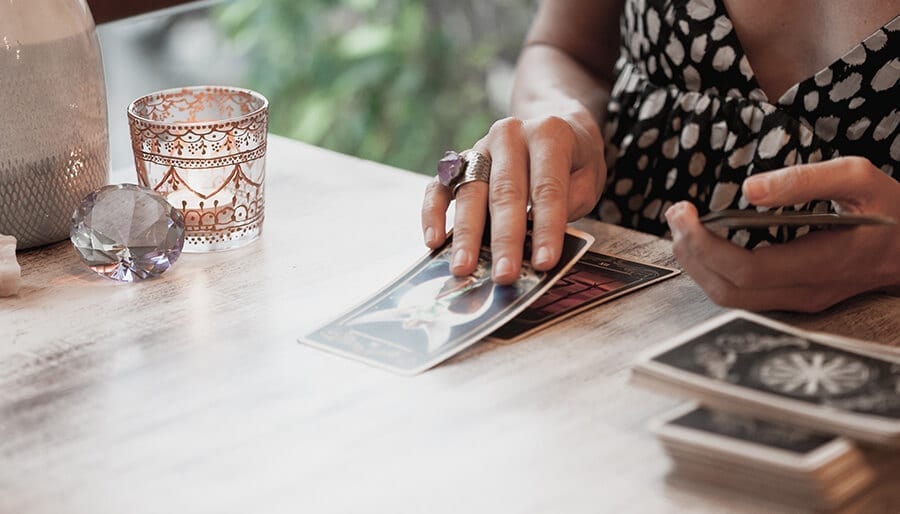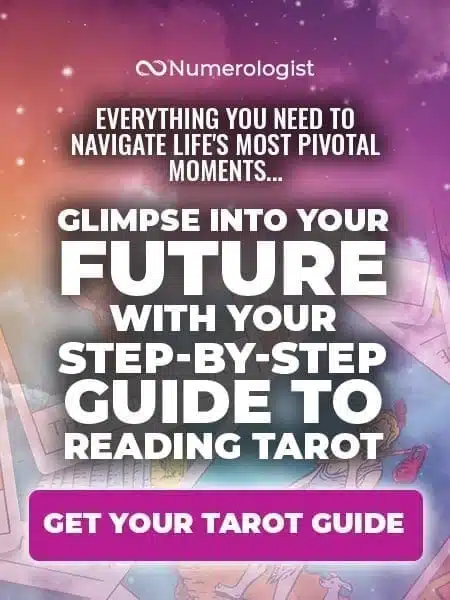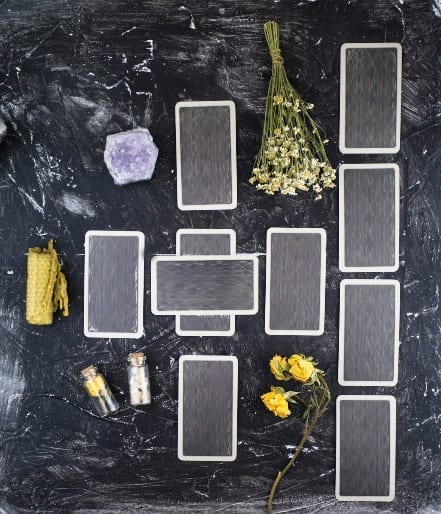If you’ve just got your hands on your very first Tarot deck, then knowing where to begin can be pretty overwhelming! That beautiful deck holds so much potential… yet it also holds so much that you’re yet to learn!
This is the reason it’s a good idea to have a handful of Tarot spreads that you can repeat and refer to, as you get to know the cards themselves.
But if you’re a seasoned pro, and used to throwing out Tarot readings like confetti, it can still be useful to go back to basics every now and again. Peeling back the layers of complexity is a great way of reminding yourself of the unending mystery that the Tarot contains.
Here we’ll go through three common Tarot spreads. These are simple, yes. But often if you keep the spread itself pared-back, then the cards can shine.
Tarot Spread 1: Daily Card Draw
Ok, not strictly a spread, the daily draw is exactly what it sounds like.
At the start of each day, simply connect to your deck, give it a shuffle and ask “What do I need to know today?”
Make a note of the card you draw, and as you go about your day, look for signs of its specific energy.
The Tarot cards meaning could manifest through a person you meet, through a project you’re asked to do at work, or a feeling you get when you read a magazine article at lunchtime.
Alternatively, look for opportunities to bring the card’s energy into your day more purposefully: Can you initiate a conversation with someone who embodies the card? Could you volunteer for that project, or seek out a book or a poem that feels like it relates?
Before you go to bed, be sure to note down anything that cropped up for you in your journal.
The point of this daily reading practice is twofold.
1. It’s THE BEST way to learn about Tarot! You are focusing on getting to know a single tarot card each day, immersing yourself in it without worrying about how it’s relating to other cards in a spread (more on that later!)
2. You’ll learn first hand how the messages of Tarot directly relate to life. This takes a Tarot reading off the table, and turns it into the practical life skill it’s meant to be.
Tarot Spread 2: Three Card Decision
For making any simple decision, there’s nothing better than a three-card spread.
From reading to reading, the three tarot cards don’t always need to indicate the same things, but it’s useful to follow this basic principle:
Draw three tarot cards face down, placing them side by side on your table. Turn over one at a time, left to right.
- Card 1 represents the past. This tarot card will reveal the issues that are affecting the situation you’re asking about. Seems obvious, but there may be things that you’re not aware of!
- Card 2 represents the present. This can help you to get really clear about what’s going on right now, and what the true focus of this query is.
- Card 3 represents the future. This tarot card helps to serve as a guide, or warning about possible outcomes of the decision you’re making.
Once you have this Tarot spread mastered (or if for any reason, you just don’t enjoy this set-up) then you can apply different meanings to the three cards, such as:
- Current situation • what’s blocking you • best next move
- Current situation • best next more • outcome
- Cause of the problem • nature of the problem • solution to the problem
- Current situation • what you desire • action to get there
There are many variations on the three-card spread! Find a few that work for you, but be sure that your intention is really clear when drawing from the deck.
CHECK OUT MORE THREE CARD TAROT SPREADS HERE
Tarot Spread 3: Celtic Cross
Probably the most well-known and popular of spreads in tarot, the Celtic Cross uses 10 cards in total. It’s often what’s used in a Tarot reading, yet it has a few variations. So if you’re used to doing it slightly differently or laying out the tarot cards in another order, nobody is doing anything wrong!
Lay the first card (1) at the center with a second card (2) placed over the top of it, turned 90º to its side. Then four cards are placed around these, like this: third card on the left (3), fourth card on the right (4), fifth card at the top (5), sixth card at the bottom (6). The final result should resemble a cross.
Then four more tarot cards are placed alongside this in a vertical line from the bottom, to the final card at the top (cards 7, 8, 9, and 10).
Check out the diagram for a visual representation of the Celtic Cross spread.
This is what each card shows:
- Card 1 – the present, and what’s currently happening in the querents life, thoughts, and perception.
- Card 2 – the immediate obstacle. This is the one thing, that if changed, would have a great and positive impact on the life of the querent.
- Card 3 – The past. How the current circumstances came to be.
- Card 4 – How the next weeks and months are likely to appear.
- Card 5 – The conscious goals and aims of the querent, in relation to the situation they are facing.
- Card 6 – The subconscious forces, patterns, and motivations that are influencing this situation. This could be a deep driving force that the querant is unaware of.
- Card 7 – Recommendations for a way ahead.
- Card 8 – Any influences that are beyond the control of the querant. These could be people, situations, or unforeseen circumstances.
- Card 9 – The hopes and fears of the querant in relation to their current situation.
- Card 10 – Outcome. This is assuming the querant sticks to their current path and course of action (and is therefore subject to change!)
This very basic overview of the Celtic Cross should be seen as a basis from which to start working. Because the layers of meaning it contains really go much deeper than each individual card.
Once each card has been read, try to see the connections between them, any patterns that are forming, and whether the first group (cards 1 – 6) seem compatible and harmonious with the second group (cards 7 – 10).
It may also be useful to look for connections between pairs of cards. For example, are card 5 (hopes and aspirations) and card 10 (outcome) aligned? And if not, do the other cards shed any light on why this is?
Free Will Rules!
It’s vital to always remember that whilst being an invaluable tool for revelation, guidance and yes, divination, Tarot does not stand in the way of free will. You can change the outcome of whatever situation you find yourself in! Use the Tarot for insight, and this becomes SO much more possible.
So, beginner or pro, what are YOUR favorite Tarot spreads? Will you share them with us in the comments below?



